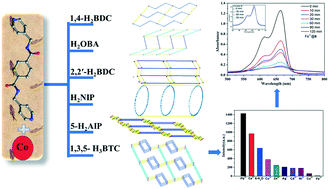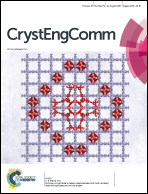Fluorescent recognition of Fe3+ and Fe3+-functionalized composite materials for enhancing photocatalytic activities of CoII complexes†
Abstract
Six new CoII coordination polymers (CPs) based on a bi-methylene-bridged semi-rigid bis-pyridyl-bis-amide ligand and various polycarboxylates, namely, [Co(4-bmbpd)(1,4-BDC)(H2O)2]·2H2O (1), [Co(4-bmbpd)(OBA)]·H2O (2), [Co(4-bmbpd)(2,2′-BDC)]·H2O (3), [Co(4-bmbpd)(5-NIP)]·2H2O (4), [Co(4-bmbpd)0.5(5-AIP)]·H2O (5), and [Co3(4-bmbpd)3(1,3,5-BTC)2(H2O)4]·4H2O (6) [4-bmbpd = N,N′-bis(4-methylenepyridin-4-yl)-1,4-benzenedicarboxamide, 1,4-H2BDC = 1,4-benzenedicarboxylic acid, H2OBA = 4,4′-oxybisbenzoic acid, 2,2′-H2BDC = 2,2′-biphenyldicarboxylic acid, H2NIP = 5-nitroisophthalic acid, 5-H2AIP = 5-aminoisophthalic acid, and 1,3,5-H3BTC = 1,3,5-benzenetricarboxylic acid] have been synthesized and structurally characterized by single-crystal X-ray diffraction analyses, IR spectroscopy, thermal gravimetric analyses (TG) and powder X-ray diffraction (PXRD). Complex 1 is a 2D 4-connected layer structure consisting of 1D [Co-(4-bmbpd)]n wave-like chains and [Co-(1,4-BDC)]n linear chains. 2 is also a 2D 4-connected network composed of 1D [Co-OBA]n linear chains and [Co-(4-bmbpd)]n wave chains. Complex 3 shows a (3,5)-connected 2D architecture based on 1D [Co-BDC]n double linear chains and 1D [Co-(4-bmbpd)]n zigzag chains with a {42·67·8}{42·6} topology. In 4, two 4-bmbpd ligands coordinate with two CoII ions in an anti-configuration to form a 38-membered [Co2(4-bmbpd2)] loop, which is further extended into a 1D tubular structure by pairs of 5-NIP anions. Coordination polymer 5 is a 3D (4,5)-connected architecture with a {44·62}{44·66} topology. 6 shows a 3D (2,3,4,4)-connected framework, which contains 1D [Co-1,3,5-BTC]n double chains. The CoII ion and 4-bmbpd ligand in the title coordination polymers show different coordination characters and conformations. The effect of organic polycarboxylates with different rigidities/lengths/substituents on the structures of CoII coordination polymers was investigated. The electrochemical behaviors of 1–3, 5 and 6, the fluorescent behaviors of 5 and 6, and the photocatalytic activities of 5, 6, and Fe3+-functionalized Fe3+@5 and Fe3+@6 composites were investigated.



 Please wait while we load your content...
Please wait while we load your content...